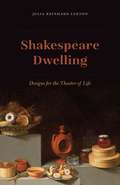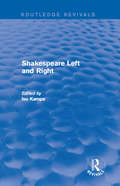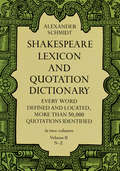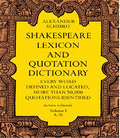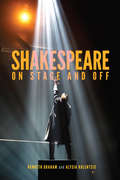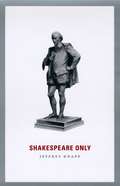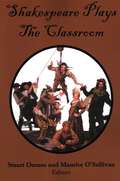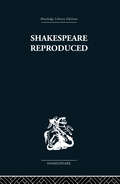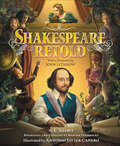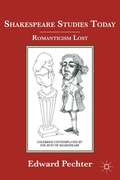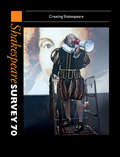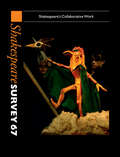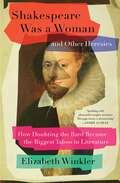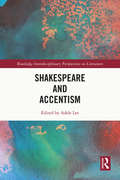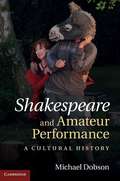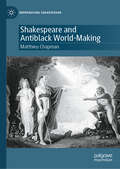- Table View
- List View
Shakespeare Beyond Doubt
by Stanley Wells Paul EdmondsonDid Shakespeare write Shakespeare? The authorship question has been much treated in works of fiction, film and television, provoking interest all over the world. Sceptics have proposed many candidates as the author of Shakespeare's works, including Francis Bacon, Christopher Marlowe and Edward De Vere, the seventeenth Earl of Oxford. But why and how did the authorship question arise and what does surviving evidence offer in answer to it? This authoritative, accessible and frequently entertaining book sets the debate in its historical context and provides an account of its main protagonists and their theories. Presenting the authorship of Shakespeare's works in relation to historiography, psychology and literary theory, twenty-three distinguished scholars reposition and develop the discussion. The book explores the issues in the light of biographical, textual and bibliographical evidence to bring fresh perspectives to an intriguing cultural phenomenon.
Shakespeare Beyond English
by Susan Bennett Christie CarsonTackling vital issues of politics, identity and experience in performance, this book asks what Shakespeare's plays mean when extended beyond the English language. From April to June 2012 the Globe to Globe Festival offered the unprecedented opportunity to see all of Shakespeare's plays performed in many different world languages. Thirty-eight productions from around the globe were presented in six weeks as part of the World Shakespeare Festival, which formed a cornerstone of the Cultural Olympics. This book provides the only complete critical record of that event, drawing together an internationally renowned group of scholars of Shakespeare and world theatre with a selection of the UK's most celebrated Shakespearean actors. Featuring a foreword by Artistic Director Dominic Dromgoole and an interview with the Festival Director Tom Bird, this volume highlights the energy and dedication that was necessary to mount this extraordinary cultural experiment.
Shakespeare Dwelling: Designs for the Theater of Life
by Julia Reinhard LuptonGreat halls and hovels, dove-houses and sheepcotes, mountain cells and seaside shelters—these are some of the spaces in which Shakespearean characters gather to dwell, and to test their connections with one another and their worlds. Julia Reinhard Lupton enters Shakespeare’s dwelling places in search of insights into the most fundamental human problems. Focusing on five works (Romeo and Juliet, Macbeth, Pericles, Cymbeline, and The Winter’s Tale), Lupton remakes the concept of dwelling by drawing on a variety of sources, including modern design theory, Renaissance treatises on husbandry and housekeeping, and the philosophies of Hannah Arendt and Martin Heidegger. The resulting synthesis not only offers a new entry point into the contemporary study of environments; it also shows how Shakespeare’s works help us continue to make sense of our primal creaturely need for shelter.
Shakespeare Left and Right (Routledge Revivals)
by Ivo KampsShakespeare Left and Right brings together critics, strikingly different in their politics and methodologies, who are acutely aware of the importance of politics on literary practice and theory. Should, for example, feminist criticism be subjected to a critique by voices it construes as hostile to its political agenda? Is it possible to present a critique of feminist criticism without implicitly impeding its politics? And, in the light of recent political events should the Right pronounce the demise of Marxism as a social science and interpretive tool? The essays in Shakespeare Left and Right, first published in 1991, present a tug of war about ideology, acted out over the body of Shakespeare. Part One focuses on the challenge thrown down by Richard Levin's widely discussed "Feminist Thematics and Shakespearean Tragedy". Part Two considers these issues in relation to critical practice and the reading of specific plays. This book should be of interest to undergraduates and academics interested in Shakespeare studies.
Shakespeare Lexicon and Quotation Dictionary (Third Edition)
by Alexander SchmidtIn more than 300 years of Shakespearean scholarship, only one book, the famous Shakespeare Lexicon and Quotation Dictionary, has investigated the meaning of every word that Shakespeare wrote. The lifetime work of Professor Alexander Schmidt of Königsberg, this book has long been the indispensable companion for every person seriously interested in Shakespeare, Renaissance poetry and prose of any sort, or English literature. It is really two important books in one. <p><p> Schmidt’s set contains every single word that Shakespeare used, not simply words that have changed their meaning since the seventeenth century, but every word in all the accepted plays and the poems. Covering both quartos and folios, it carefully distinguishes between shades of meaning for each word and provides exact definitions, plus governing phrases and locations, down to the numbered line of the Cambridge edition of Shakespeare. There is no other word dictionary comparable to this work. <p> Even more useful to the general reader, however, is the incredible wealth of exact quotations. Arranged under the words of the quotation itself (hence no need to consult confusing subject classifications) are more than 50,000 exact quotations. Each is precisely located, so that you can easily refer back to the plays or poems themselves, if you wish context.Other features helpful to the scholar are appendixes on basic grammatical observations, a glossary of provincialisms, a list of words and sentences taken from foreign languages, a list of words that form the latter part of word-combinations. This third edition features a supplement with new findings.
Shakespeare Lexicon and Quotation Dictionary: A Complete Dictionary Of All The English Words, Phrases, And Constructions In The Works Of The Poet (Third Edition)
by Alexander SchmidtIn more than 300 years of Shakespearean scholarship, only one book, the famous Shakespeare Lexicon and Quotation Dictionary, has investigated the meaning of every word that Shakespeare wrote. The lifetime work of Professor Alexander Schmidt of Königsberg, this book has long been the indispensable companion for every person seriously interested in Shakespeare, Renaissance poetry and prose of any sort, or English literature. It is really two important books in one. <p><p> Schmidt’s set contains every single word that Shakespeare used, not simply words that have changed their meaning since the seventeenth century, but every word in all the accepted plays and the poems. Covering both quartos and folios, it carefully distinguishes between shades of meaning for each word and provides exact definitions, plus governing phrases and locations, down to the numbered line of the Cambridge edition of Shakespeare. There is no other word dictionary comparable to this work. <p> Even more useful to the general reader, however, is the incredible wealth of exact quotations. Arranged under the words of the quotation itself (hence no need to consult confusing subject classifications) are more than 50,000 exact quotations. Each is precisely located, so that you can easily refer back to the plays or poems themselves, if you wish context.Other features helpful to the scholar are appendixes on basic grammatical observations, a glossary of provincialisms, a list of words and sentences taken from foreign languages, a list of words that form the latter part of word-combinations. This third edition features a supplement with new findings.
Shakespeare On Stage and Off
by Kenneth Graham Alysia KolentsisToday, debates about the cultural role of the humanities and the arts are roiling. Responding to renewed calls to reassess the prominence of canonical writers, Shakespeare On Stage and Off introduces new perspectives on why and how William Shakespeare still matters. <p><p>Lively and accessible, the book considers what it means to play, work, and live with Shakespeare in the twenty-first century. Contributors – including Antoni Cimolino, artistic director of the Stratford Festival – engage with contemporary stagings of the plays, from a Trump-like Julius Caesar in New York City to a black Iago in Stratford-upon-Avon and a female Hamlet on the Toronto stage, and explore the effect of performance practices on understandings of identity, death, love, race, gender, class, and culture. Providing an original approach to thinking about Shakespeare, some essays ask how the knowledge and skills associated with working lives can illuminate the playwright's works. Other essays look at ways of interacting with Shakespeare in the digital age, from Shakespearean resonances in Star Trek and Indian films to live broadcasts of theatre performances, social media, and online instructional tools. Together, the essays in this volume speak to how Shakespeare continues to enrich contemporary culture. <p><p>A timely guide to the ongoing importance of Shakespearean drama, Shakespeare On Stage and Off surveys recent developments in performance, adaptation, popular culture, and education. <p><p>Contributors include Russell J. Bodi (Owens State Community College), Christie Carson (Royal Holloway University of London), Brandon Christopher (University of Winnipeg), Antoni Cimolino (Stratford Festival), Jacob Claflin (College of Eastern Idaho), Lauren Eriks Cline (University of Michigan), David B. Goldstein (York University), Gina Hausknecht (Coe College), Peter Holland (University of Notre Dame), R.W. Jones (University of Texas), Christina Luckyj (Dalhousie University), Julia Reinhard Lupton (University of California, Irvine), Linda McJannet (Bentley University), Roderick H. McKeown (University of Toronto), Hayley O'Malley (University of Michigan), Amrita Sen (University of Calcutta), Eric Spencer (The College of Idaho), Lisa S. Starks (University of South Florida St Petersburg), and Jeffrey R. Wilson (Harvard University).
Shakespeare On Stage and Off
by Kenneth Graham and Alysia KolentsisToday, debates about the cultural role of the humanities and the arts are roiling. Responding to renewed calls to reassess the prominence of canonical writers, Shakespeare On Stage and Off introduces new perspectives on why and how William Shakespeare still matters. Lively and accessible, the book considers what it means to play, work, and live with Shakespeare in the twenty-first century. Contributors - including Antoni Cimolino, artistic director of the Stratford Festival - engage with contemporary stagings of the plays, from a Trump-like Julius Caesar in New York City to a black Iago in Stratford-upon-Avon and a female Hamlet on the Toronto stage, and explore the effect of performance practices on understandings of identity, death, love, race, gender, class, and culture. Providing an original approach to thinking about Shakespeare, some essays ask how the knowledge and skills associated with working lives can illuminate the playwright's works. Other essays look at ways of interacting with Shakespeare in the digital age, from Shakespearean resonances in Star Trek and Indian films to live broadcasts of theatre performances, social media, and online instructional tools. Together, the essays in this volume speak to how Shakespeare continues to enrich contemporary culture. A timely guide to the ongoing importance of Shakespearean drama, Shakespeare On Stage and Off surveys recent developments in performance, adaptation, popular culture, and education. Contributors include Russell J. Bodi (Owens State Community College), Christie Carson (Royal Holloway University of London), Brandon Christopher (University of Winnipeg), Antoni Cimolino (Stratford Festival), Jacob Claflin (College of Eastern Idaho), Lauren Eriks Cline (University of Michigan), David B. Goldstein (York University), Gina Hausknecht (Coe College), Peter Holland (University of Notre Dame), R.W. Jones (University of Texas), Christina Luckyj (Dalhousie University), Julia Reinhard Lupton (University of California, Irvine), Linda McJannet (Bentley University), Roderick H. McKeown (University of Toronto), Hayley O'Malley (University of Michigan), Amrita Sen (University of Calcutta), Eric Spencer (The College of Idaho), Lisa S. Starks (University of South Florida St Petersburg), and Jeffrey R. Wilson (Harvard University).
Shakespeare Only
by Jeffrey KnappThree decades of controversy in Shakespeare studies can be summed up in a single question: Was Shakespeare one of a kind? On one side of the debate are the Shakespeare lovers, the bardolatrists, who insist on Shakespeare’s timeless preeminence as an author. On the other side are the theater historians who view modern claims of Shakespeare’s uniqueness as a distortion of his real professional life. In Shakespeare Only, Knapp draws on an extraordinary array of historical evidence to reconstruct Shakespeare’s authorial identity as Shakespeare and his contemporaries actually understood it. He argues that Shakespeare tried to adapt his own singular talent and ambition to the collaborative enterprise of drama by imagining himself as uniquely embodying the diverse, fractious energies of the popular theater. Rewriting our current histories of authorship as well as Renaissance drama, Shakespeare Only recaptures a sense of the creative force that mass entertainment exerted on Shakespeare and that Shakespeare exerted on mass entertainment.
Shakespeare Performance Studies
by W. B. WorthenTaking a 'performance studies' perspective on Shakespearean theatre, W. B. Worthen argues that the theatrical event represents less an inquiry into the presumed meanings of the text than an effort to frame performance as a vehicle of cultural critique. Using contemporary performances as test cases, Worthen explores the interfaces between the origins of Shakespeare's writing as literature and as theatre, the modes of engagement with Shakespeare's plays for readers and spectators, and the function of changing performance technologies on our knowledge of Shakespeare. This book not only provides the material for performance analysis, but places important contemporary Shakespeare productions in dialogue with three influential areas of critical discourse: texts and authorship, the function of character in cognitive theatre studies, and the representation of theatre and performing in the digital humanities. This book will be vital reading for scholars and advanced students of Shakespeare and of Performance Studies.
Shakespeare Plays the Classroom
by Stuart E. Omans and Maurice J. O’SullivanBringing Shakespeare to the Sunshine State, this book gathers together a talented group of teachers, choreographers, directors, set designers, musicians, costumers, actors, and artists to discuss how they have adapted the bard's monologues in Miami, assassinated Julius Caesar on the steps of Tallahassee's Capitol, trained students to duel in Florida's Panhandle, placed Shylock on trial in Orlando, and transformed Gainesville into Puck's magical forest. This guide for teachers and lovers of literature and theater is an original collection of essays exploring the idea that Shakespeare's plays are best approached playfully through performance. Based on their wide-ranging experience as theater professionals and teachers in Florida, New York, London, and Stratford, the authors celebrate Shakespeare's continuing appeal to our complex, diverse culture. The essays include reflections on acting by the Royal Shakespeare Company's longest-serving member. And there's practical advice on acting; directing; staging fights; designing costumes; and integrating music, dance, masks, and puppets into performances from teachers and others who have refined their methods by performing Shakespeare in the classroom.
Shakespeare Reproduced: The text in history and ideology
by Jean E Howard Marion F O’ConnorFirst published in 1987. The essays in Shakespeare Reproduced offer a political critique of Shakespeare's writings and the uses to which those writings are put Some of the essays focus on Shakespeare in his own time and consider how his plays can be seen to reproduce or subvert the cultural orthodoxies and the power relations of the late Renaissance. Others examine the forces which have produced an overtly political criticism of Shakespeare and of his use in culture. Contributors include: Jean E Howard and Marion O'Connor, Walter Cohen, Don E Wayne, Thomas Cartelli, Peter Erickson, Karen Newman, Thomas Moisan, Michael D Bristol, Thomas Sorge, Jonathan Goldberg, Robert Weimann, Margaret Ferguson.
Shakespeare Retold
by E. NesbitA beautifully illustrated collection of prose retellings of seven Shakespeare plays will bring the Bard to life for young readers. Not only is this a beautiful keepsake edition, full of gorgeous illustrations by Antonio Javier Caparo, but the prose retellings by beloved classic children’s book author E. Nesbit are an excellent tool to introduce children to the complex language of Shakespeare.A foreword by John Lithgow touches on his own childhood as a Shakespearean actor and the importance of Shakespeare. The book contains extensive support materials, including a biography, a timeline of Shakespeare’s life, and further recommended readings.In this volume, you will find:Romeo and JulietA Midsummer Night’s DreamTwelfth NightHamletMacbethThe TempestMuch Ado About Nothing
Shakespeare Studies Today
by Edward PechterThe Romantics invented Shakespeare studies, and in losing contact with our origins, we have not been able to develop an adequate alternative foundation on which to build our work. This book asserts that among Shakespeareans at present, the level of conviction required to sustain a healthy critical practice is problematically if not dangerously low, and the qualities which the Romantics valued in an engagement with Shakespeare are either ignored these days or fundamentally misunderstood.
Shakespeare Survey 70: Creating Shakespeare (Shakespeare Survey #70)
by Peter HollandThe seventieth volume in the annual series of volumes devoted to Shakespeare study and production. The articles are drawn from the World Shakespeare Congress, held 400 years after Shakespeare's death, in July/August 2016 in Stratford-upon-Avon and London. The theme is 'Creating Shakespeare'.
Shakespeare Survey: Shakespeare Survey
by Peter Holland Emma Peter Smith Emma Smith HollandShakespeare Survey is a yearbook of Shakespeare studies and production. Since 1948 Survey has published the best international scholarship in English and many of its essays have become classics of Shakespeare criticism. Each volume is devoted to a theme, or play, or group of plays; each also contains a section of reviews of the previous year's textual and critical studies and of major British performances. The books are illustrated with a variety of Shakespearean images and production photographs. The current editor of Survey is Peter Holland. The first eighteen volumes were edited by Allardyce Nicoll, numbers 19-33 by Kenneth Muir and numbers 34-52 by Stanley Wells. The virtues of accessible scholarship and a keen interest in performance, from Shakespeare's time to our own, have characterised the journal from the start. For the first time, numbers 1-50 are being reissued in paperback, available separately and as a set.
Shakespeare Survey: Volume 62, Close Encounters with Shakespeare's Text
by Peter HollandShakespeare Survey is a yearbook of Shakespeare studies and production. Since 1948 Survey has published the best international scholarship in English and many of its essays have become classics of Shakespeare criticism. Each volume is devoted to a theme, or play, or group of plays; each also contains a section of reviews of the previous year's textual and critical studies and of major British performances. The books are illustrated with a variety of Shakespearean images and production photographs. The current editor of Survey is Peter Holland. The first eighteen volumes were edited by Allardyce Nicoll, numbers 19-33 by Kenneth Muir and numbers 34-52 by Stanley Wells. The virtues of accessible scholarship and a keen interest in performance, from Shakespeare's time to our own, have characterized the journal from the start. For the first time, numbers 1-50 are being reissued in paperback, available separately and as a set.<P> The theme for volume 62 is 'Close Encounters with Shakespeare's Text'. The complete set of Survey volumes is also available online at http://www.cambridge.org/online/shakespearesurvey. This fully-searchable resource enables users to browse by author, essay and volume, search by play, theme and topic, and save and bookmark their results.
Shakespeare Survey: Volume 64, Shakespeare as Cultural Catalyst
by Peter HollandShakespeare Survey is a yearbook of Shakespeare studies and production. Since 1948 Survey has published the best international scholarship in English and many of its essays have become classics of Shakespeare criticism. Each volume is devoted to a theme, or play, or group of plays; each also contains a section of reviews of the previous year's textual and critical studies and of major British performances. The books are illustrated with a variety of Shakespearean images and production photographs. The current editor of Survey is Peter Holland. The first eighteen volumes were edited by Allardyce Nicoll, numbers 19-33 by Kenneth Muir and numbers 34-52 by Stanley Wells. The virtues of accessible scholarship and a keen interest in performance, from Shakespeare's time to our own, have characterized the journal from the start. For the first time, numbers 1-50 are being reissued in paperback, available separately and as a set.<P> The theme for volume 64 is 'Shakespeare as Cultural Catalyst'. The complete set of Survey volumes is also available online at http://www.cambridge.org/online/shakespearesurvey. This fully-searchable resource enables users to browse by author, essay and volume, search by play, theme and topic, and save and bookmark their results.
Shakespeare Survey: Volume 65, A Midsummer Night's Dream
by Peter HollandShakespeare Survey is a yearbook of Shakespeare studies and production. Since 1948 Survey has published the best international scholarship in English and many of its essays have become classics of Shakespeare criticism. Each volume is devoted to a theme, or play, or group of plays; each also contains a section of reviews of the previous year's textual and critical studies and of major British performances. The books are illustrated with a variety of Shakespearean images and production photographs. The current editor of Survey is Peter Holland. The first eighteen volumes were edited by Allardyce Nicoll, numbers 19-33 by Kenneth Muir and numbers 34-52 by Stanley Wells. The virtues of accessible scholarship and a keen interest in performance, from Shakespeare's time to our own, have characterized the journal from the start. For the first time, numbers 1-50 are being reissued in paperback, available separately and as a set.<P> The theme for Volume 65 is 'A Midsummer Night's Dream'. The complete set of Survey volumes is also available online at http://www.cambridge.org/online/shakespearesurvey. This fully searchable resource enables users to browse by author, essay and volume, search by play, theme and topic and save and bookmark their results.
Shakespeare Survey: Volume 66, Working with Shakespeare
by Peter HollandShakespeare Survey is a yearbook of Shakespeare studies and production. Since 1948 Survey has published the best international scholarship in English and many of its essays have become classics of Shakespeare criticism. Each volume is devoted to a theme, or play, or group of plays; each also contains a section of reviews of the previous year's textual and critical studies and of major British performances. The books are illustrated with a variety of Shakespearean images and production photographs. The current editor of Survey is Peter Holland. The first eighteen volumes were edited by Allardyce Nicoll, numbers 19-33 by Kenneth Muir and numbers 34-52 by Stanley Wells. The virtues of accessible scholarship and a keen interest in performance, from Shakespeare's time to our own, have characterized the journal from the start. For the first time, numbers 1-50 are being reissued in paperback, available separately and as a set. <P> The theme for Volume 66 is 'Working with Shakespeare', and Tiffany Stern's essay has been selected by the Medieval and Renaissance Drama Society for its Barbara Palmer/Martin Stevens award for best new essay in early drama studies, 2014. The complete set of Survey volumes is also available online at http://www.cambridge.org/online/shakespearesurvey. This fully searchable resource enables users to browse by author, essay and volume, search by play, theme and topic and save and bookmark their results.
Shakespeare Survey: Volume 67, Shakespeare's Collaborative Work
by Peter Holland Ton HoenselaarsShakespeare Survey is a yearbook of Shakespeare studies and production. Since 1948 Survey has published the best international scholarship in English and many of its essays have become classics of Shakespeare criticism. Each volume is devoted to a theme, or play, or group of plays; each also contains a section of reviews of the previous year's textual and critical studies and of major British performances. The books are illustrated with a variety of Shakespearean images and production photographs. The current editor of Survey is Peter Holland. The first eighteen volumes were edited by Allardyce Nicoll, numbers 19-33 by Kenneth Muir and numbers 34-52 by Stanley Wells. The virtues of accessible scholarship and a keen interest in performance, from Shakespeare's time to our own, have characterized the journal from the start. For the first time, numbers 1-50 are being reissued in paperback, available separately and as a set.<P> The theme for Volume 67 is 'Shakespeare's Collaborative Work'. The complete set of Survey volumes is also available online at http://www.cambridge.org/online/shakespearesurvey. This fully searchable resource enables users to browse by author, essay and volume, search by play, theme and topic, and save and bookmark their results.
Shakespeare Was a Woman and Other Heresies: How Doubting the Bard Became the Biggest Taboo in Literature
by Elizabeth WinklerAn &“extraordinarily brilliant&” and &“pleasurably naughty&” (André Aciman) investigation into the Shakespeare authorship question, exploring how doubting that William Shakespeare wrote his plays became an act of blasphemy…and who the Bard might really be.The theory that Shakespeare may not have written the works that bear his name is the most horrible, unspeakable subject in the history of English literature. Scholars admit that the Bard&’s biography is a &“black hole,&” yet to publicly question the identity of the god of English literature is unacceptable, even (some say) &“immoral.&” In Shakespeare Was a Woman and Other Heresies, journalist and literary critic Elizabeth Winkler sets out to probe the origins of this literary taboo. Whisking you from London to Stratford-Upon-Avon to Washington, DC, she pulls back the curtain to show how the forces of nationalism and empire, religion and mythmaking, gender and class have shaped our admiration for Shakespeare across the centuries. As she considers the writers and thinkers—from Walt Whitman to Sigmund Freud to Supreme Court justices—who have grappled with the riddle of the plays&’ origins, she explores who may perhaps have been hiding behind his name. A forgotten woman? A disgraced aristocrat? A government spy? Hovering over the mystery are Shakespeare&’s plays themselves, with their love for mistaken identities, disguises, and things never quite being what they seem. As she interviews scholars and skeptics, Winkler&’s interest turns to the larger problem of historical truth—and of how human imperfections (bias, blindness, subjectivity) shape our construction of the past. History is a story, and the story we find may depend on the story we&’re looking for. &“Lively&” (The Washington Post), &“fascinating&” (Amanda Foreman), and &“intrepid&” (Stacy Schiff), Shakespeare Was a Woman and Other Heresies will forever change how you think of Shakespeare…and of how we as a society decide what&’s up for debate and what&’s just nonsense, just heresy.
Shakespeare and Accentism (Routledge Interdisciplinary Perspectives on Literature)
by Adele LeeThis collection explores the consequences of accentism—an under-researched issue that intersects with racism and classism—in the Shakespeare industry across languages and cultures, past and present. It adopts a transmedia and transhistorical approach to a subject that has been dominated by the study of "Original Pronunciation." Yet the OP project avoids linguistically "foreign" characters such as Othello because of the additional complications their "aberrant" speech poses to the reconstruction process. It also evades discussion of contemporary, global practices and, underpinning the enterprise, is the search for an aural "purity" that arguably never existed. By contrast, this collection attends to foreign speech patterns in both the early modern and post-modern periods, including Indian, East Asian, and South African, and explores how accents operate as "metasigns" reinforcing ethno-racial stereotypes and social hierarchies. It embraces new methodologies, which includes reorienting attention away from the visual and onto the aural dimensions of performance.
Shakespeare and Amateur Performance
by Michael DobsonFrom the Hamlet acted on a galleon off Africa to the countless outdoor productions of A Midsummer Night's Dream that now defy each English summer, Shakespeare and Amateur Performance explores the unsung achievements of those outside the theatrical profession who have been determined to do Shakespeare themselves. Based on extensive research in previously unexplored archives, this generously illustrated and lively work of theatre history enriches our understanding of how and why Shakespeare's plays have mattered to generations of rude mechanicals and aristocratic dilettantes alike: from the days of the Theatres Royal to those of the Little Theatre Movement, from the pioneering Winter's Tale performed in eighteenth-century Salisbury to the Merchant of Venice performed by Allied prisoners for their Nazi captors, and from the how-to book which transforms Mercutio into Yankee Doodle to the Napoleonic counterspy who used Richard III as a tool of surveillance.
Shakespeare and Antiblack World-Making (Reproducing Shakespeare)
by Matthieu ChapmanThis book is about Shakespeare&’s role in sustaining the antiblack paradigm of modernity. This work re-reads both Shakespearean texts and performances from the 16th century to the present to argue that American and English societies have deployed Shakespeare for four hundred years as a mechanism to construct and reinforce paradigmatic antiblackness. Framed within the author&’s experiences as a Black scholar, actor, and director of Shakespeare and using both contemporary Critical Race Theory (CRT), as well as Pre-Modern Critical Race Studies (PCRS), this book uses civil society&’s engagement with and performance of Shakespeare in various times and places to reveal the continuum of antiblackness that predates chattel slavery in America and contributes to antiblack world-making across oceans and centuries.

